Intoduction
Almost 50 years ago, just around the times when engineer Stephen Russell created and ran the game Spacewar! on a car-sized PDP-1 computer at the MIT labs (Juul, 2001), Umberto Eco published his book The Open Work (1962). In this book, Eco defines "open works" as narratives that manifest themselves as the reader interferes with them. They invite readers not only to interprete the text, but to play an active role in their configuration as texts. They provide the readers with a set of rules and elements that may be combined randomly to yield a large number of text variations. We speak of emergent yet coherent narratives here. A large number of variations come to life. Yet each one of them individually makes sense as an aesthetic experience. Two examples of such permutative narratives are George Perec's Life: A Manual, and Raymond Queneau's A Hundred Billion Poems.

A Hundred Billion Poems
Ludology seems to be convinced that only games possess this quality of emergence. To many ludologists, “narrative” (which they perceive as being of a “scripted” nature) is against the emergent nature of games. Jesper Juul for example says that when you apply narrative to games, you destroy their emergent character and they turn into games of progession (2002). However, Eco’s work, and the literature examples above, clearly show that narrativity and emergence aren’t mutually exclusive. This urges me to rethink the notion of “emergence”: Can we speak of emergence as being the nature of only certain media, but not others? Can we safely assume that there is a type of medium that renders “emergent” every instance of its use?I believe that Ludologists come to a too hasty conclusion in regard to games being emergent by their very nature. Interactivity seems to be enough to convince Ludology that game system are truly non-linear. I see two problems here: 1) The need to explain patterns in emergent behavior. 2) A theorethical challenge: Could it be that emergence needs to be crafted artificially rather than being the nature of games? In this article I will elaborate on these two problems.
Emergent Behavior and the Necessity Cap
There is a famous quote of Berthold Brecht: “The shortest line between two points –if there’s an obstacle inbetween- is a curve.”
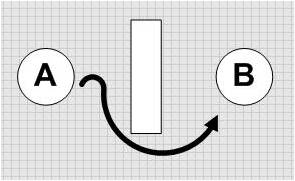
Brecht Quote
This is actually a very good definition of the notion of conflict in classical drama theory. Technically speaking, any character who is trying to solve a conflict is subject to necessity. Necessity addresses the fact that there is a force at play that keeps the character on search for a optimal solution to the conflict that she is facing. In other words, necessity renders “logical” and meaningful only certain types of actions. In the light of necessity, only a limited part of the available possibility space is of use; the useless parts will probably never be discovered. This means that even if we could, we do not simply roam freely in the open world: Our actions are rather motivated and telic. This goal-orientedness causes patterns to emerge in the ongoing emergent behavior. Drama theory addresses these issues under the topic of motivation and asks the following questions: “Why can the character not simply walk away and ignore the challenge? When arriving at decision nodes, why does the character chose what is good for the story?" To illustrate the point, let’s have a look at a formal game with emergent qualities: Tetris.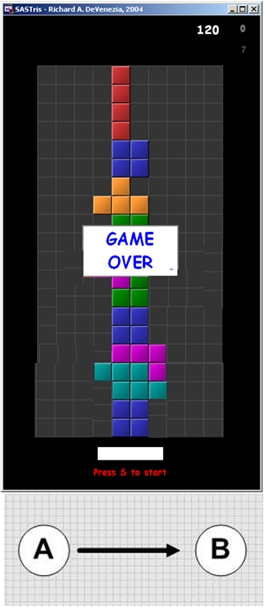
Straight into defeat!
Doing nothing results in a straight line from A to B. 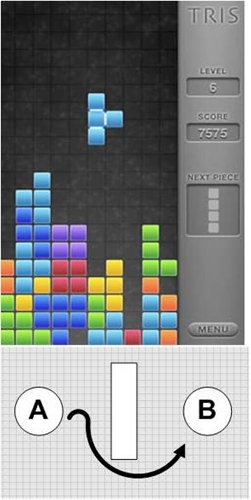
Accepting the challenge creates curves!
But if we attempt to change this algorithmic fate, we draw a curve!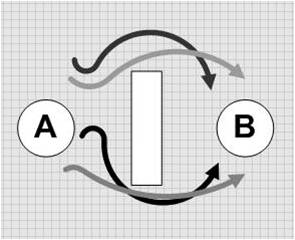
Loose again, loose better!
The more we try, the more curves we create!This may still look like we have a lot of emergence and non-linearity here. Yet to me the non-linearity that emerges here is rather limited. I see in all this some quite linear drama! While every playing session may vary considerably, we basically push ourselves through the same A --> B sequence over and over again. In other words, the system is quite deterministic, and player behavior is quite patterned.But why? Because we are motivated by necessity. This doesn’t leave much space for the type of deviation and free-roaming we credit non-linearity for. Necessity puts an invisible cap on experimentations; a cap which I call the Necessity Cap. Chaos theory would probably consider these types of games as examples of aperiodic behavior, something that is slightly less linear than linearity. In each “free” iteration similar behavior emerges due to the forces that are at play. In aperodic behavior, there is a single attractor that structures emergent behavior so that it takes similar shapes while on its way to a predictable end. 
Strange Attractor!
We could say that in most video games, necessity works like an attractor. Hence emergent player behavior in these games tends to display a pattern. In his On Certainty, Wittgenstein uses a metaphor for player moves that fits the attractor notion perfectly: "I do not explicitly learn the propositions that stand fast for me. I can discover them subsequently like the axis around which a body rotates. This axis is not fixed in the sense that anything holds it fast, but the movement around it determines its immobility" [emphasis is mine] (1969: 22). Necessity forces us to find a solution, and as we move and try, our actions help a goal to crystalize.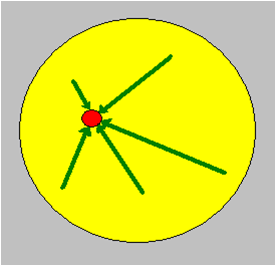
One goal, many solutions
The overall narrative construct that we face here then can be said to be quite predictable, linear, and closed. Hence I dare to call these kind of "emergent" games pseudo-non-linear: Despite their openness, these games are built around relatively narrow possibility space and an essentially linear premise. They are much more a repetition of the same sequence of events as of being truly open-ended and non-linear.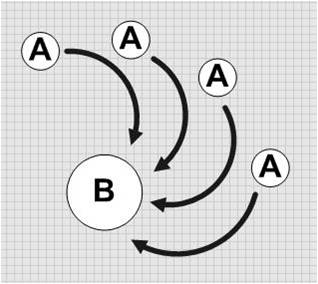
Patterns in Emergent Gameplay
Controlled Emergence as a Design AchievementMy second question was asking whether we can safely assume that the game medium renders every instance of its use emergent. Looking at the relationship between game difficulty and possibility space may give us an idea. Have a look at the diagram below: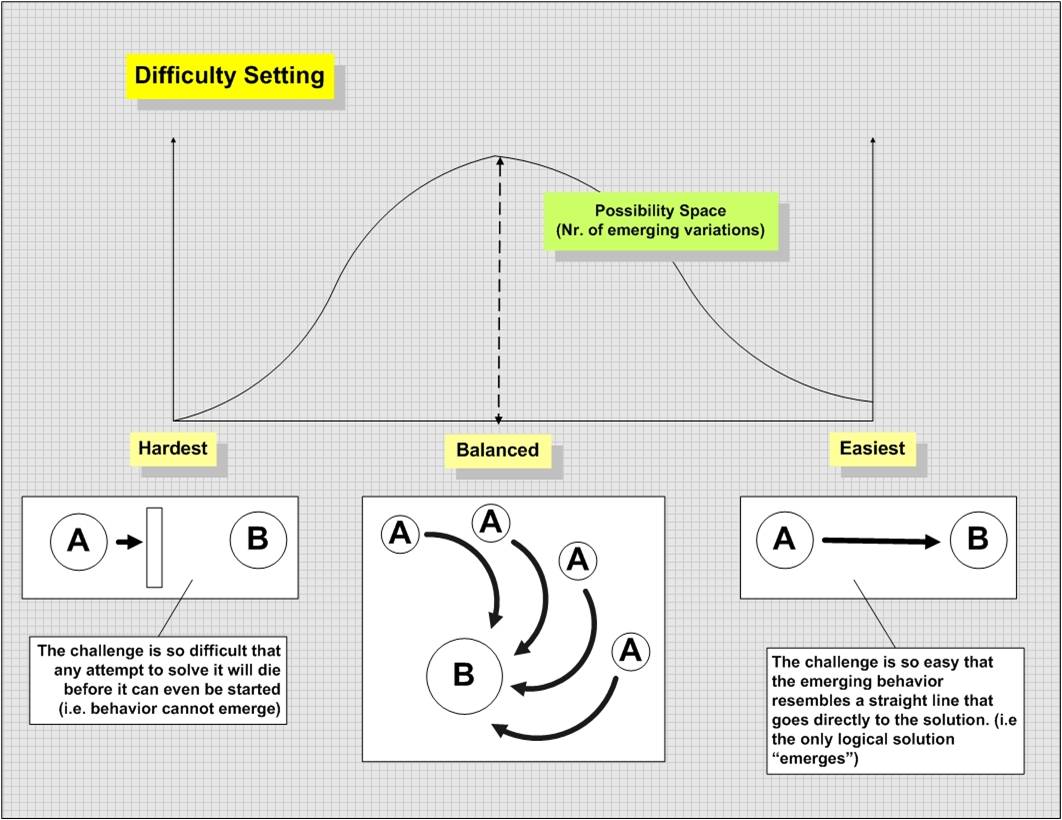
Possibility Space and Inreasing and Decreasing Difficulty
Considering the diagram, we may claim that under certain conditions a non-linear system may turn linear, and vice versa. This situation seems to put a dent to claims that emergence is the “nature” of the game medium. Actually, we could say that under certain conditions games resist to ambitions of emergence. In other words, the designer has to craft and maintain the conditions of emergence.For example using save-points and extra-lives is a way to artificially overcome problems of insufficient possibility space under hard difficulty settings.My conclusion here is that neither games nor narratives have a “nature” that by default allows us to label them as open or closed. Maybe we are just making the mistake of seeing the aesthetic conventions of a certain historical mode of production in a particular medium as the nature of that medium. [1]ConclusionBoth linearity and non-linearity are design achievements, depending on authorial skill and intention. The medium won’t do the work for us, because it does not recognize linearity or non-linearity. It just makes itself available to our vision and it’s up to us to realize that vision by bending the medium as to serve our needs. If we manage to keep it linear, it will be linear. If we manage to keep it non-linear, it will be non-linear. And if we manage to do so, it will start out emergent, but collapse into a state in which nothing can emerge anymore.Notes[1] Similarily, Raph Koster in a recent interview with gamasutra's Leigh Alexander and on his own blog put forward the idea that immersion was a style of the past, thereby connecting the notion of immersion to a certain historical mode of production, and breaking the naturalization around it.ReferencesEco U. (1987) Açık Yapıt. (trans. Yakup Şahan). İstanbul: Kabalcı.Juul J. (2002). “The Open and the Closed: Games of Emergence and Games of Progression”. http://www.jesperjuul.net/text/openandtheclosed.htmlJuul J. (2001). “A History of the Computer Game”. http://www.jesperjuul.net/thesis/2-historyofthecomputergame.htmlSardar Z. and Abrams I. (2010). Kaos: Düzensizlikteki Düzeni Anlamak İçin Çizgibilim. (trans. Deniz Guliyeva). İstanbul: NTV Yayınları.Wittgenstein L. (1969). On Certainty. (trans. Denis Paul and G.E.M. Anscombe). New York: Harper Torchbooks.[This article is based on my talk "The Open and the Closed: Notes on Game Narrativity" presented at the International Symposium of Electronic Arts, İstanbul, September 16, 2011. You can download the presentation slides here.]








